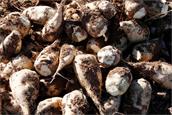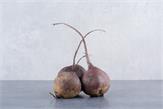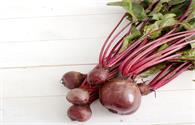2. Морковь, редис и свёкла богаты углеводами.
3. Некоторые корнеплоды можно употреблять свежими.
5. Чтобы производить высокий урожай корней, растения должны иметь хорошо развитую надземную часть.
6. Лёгкие почвы, используемые для выращивания корнеплодов, не должны быть кислыми.
7. Сорняки уничтожаются с помощью гербицидов.
b)
1. Так как корни моркови, свёклы, редиса и других корнеплодов водянистые, их трудно хранить.
2. Во время развития корней температура должна быть несколько выше, чем при развитии ботвы.
3. Корнеплоды лучше всего растут на супесчаных почвах при условии, если последние не кислые.
4. Чем плодороднее и глубже почва, тем выше урожай корней.
5. На выращивание корнеплодов большое влияние оказала механизация выращивания и уборки корней.
6.
 |
Гербициды, применяемые до или после появления всходов, способствуют хорошему росту корнеплодов.
Comprehension activities
5. Make up sentnces matching their parts.
| 1. Carrots and parsnips differ in that the former is grown for roots 2. A high yield of radishes may be obtained 3. Redishes cannot be transported for long distance 4. The farms of our region which produced a lot of carrots last year 5. The foliage will not develop properly 6. Now commercial growing of root crops can be done on a larger scale | a) since they are high in water. b) provided the soil is limed and manured. c) unless the temperature is high enough. d) because the machines and herbicides facilitate their production. e) provided all the towns of the region with this vegetable. f) while the latter for both roots and tops. |
6. Answer the following questions to text A:
1. What are the roots of vegetable crops high in?
2. How can sugar beets and their by-products be used?
3. What are the main factors affecting the growth of roots?
4. Do root crops need high temperature during the whole growing season?
5. On what kind of soil do root crops grow best?
6. What are the new developments that have changed root crop drawing?
 |
7. Read text B without a dictionary. Identify the meaning of the words in bold according to their Russian equivalents and to the context.
Text В
Beets
Beet crop is one of the most widely grown root crops. There are two major groups of beets, sugar beets and table beets. Both of them are best adapted to growing in the temperate climate.
Table beets are generally consumed when young, a few weeks after planting. They are about 8% carbohydrates and 2% protein. Cultivated beets are believed to have been originated from the wild beet of northern Europe, Beta maritima (lat.). Table beets are likely to have been developed as a garden crop only in the 16th century.
Sugar beets have much more commercial value than table beets. Through selection and breeding sugar content has been increased from 2 to 4% that is normal in table beets to as much as 20%. Most of the crop is grown in Europe including the Russian Federation.
A good percentage of soil organic matter supplied naturally, by manuring or by legume residues favours best yields. Loam or sandy loam soils predominate in most of the sugar beets areas, but heavy soils are also used to some extent, through the latter are less favourable for high yields. The sugar content of beets is highest on soils that also produce best yields.
Irrigation water is necessary for successful commercial sugar beet production where rainfall is less than about 18 inches.
The crop has the highest sugar content in areas where summer temperature averages about 67 to 72°F. The plant is not injured by cool nights. Cool automn weather favours sugar accumulation in the roots.
Sugar beets are usually grown in rotations including a legume crop, a small grain crop, and frequently potatoes, corn, or beans. The growing of sugar beets in the continuous culture results in reduced yields due to different diseases.
Sugar beets should be left in the field until they reach a maximum sugar content. Maturity is indicated by browning the lower leaves and yellowing the upper ones.
8. Report which type of beet is given more attention in text B and why. Speak about the relationship between the yield and sugar content of the beet. Explain why it is not advisible to grow beets on the same soil every year. Summarise the main idea of text В . Make the summary of text B (in Russian and in English).
 |
Listening and Speaking Focus
Watch the video: Growing Beets from Sowing to Harvest https://www.youtube.com/watch?v=1D1LLkLi8oM
a) answer the questions below:
1. Should beets be a staple of every vegetable garden?
2. Are they really easy to grow from seed?
3. Do they need special aftercare to avoid overcrowding?
4. What are some simple guidelines to help you harvest a bumper crop of beets?
b) make a summary of the video.
9. Discussion. What factors are of the greatest importance in increasing yields of beet crops?
UNIT 20. ALFALFA
| In this unit you will learn: | Grammar focus: - -ing-forms (revision). - Word meaning should (revision). - Nouns in Common Case Used as Attribute to Noun. Vocabulary focus Reading and comprehension focus: - Text A. Alfalfa. - Text B. Listening and speaking focus |
Grammar Focus
-ing- forms

| Различить причастие, герундий и отглагольное существительное можно только в предложении, потому что вне контекста они выглядят абсолютно одинаково: слово «living» может означать и «живущий» (причастие), и «жизнь» (существительное), и «жить» или «проживание» (герундий). |
Окончание -ing в английском языке можно добавить ко всем глаголам, даже к тем, что не употребляются во временах группы Continuous. Словоформы, которые получаются в итоге такого «сложения», могут быть причастием, герундием или отглагольным существительным. Умение различать эти формы в тексте помогает лучше понимать смысл и, как следствие, правильно переводить их на русский.
В таблице перечислены основные отличия между причастием, герундием и отглагольным существительным.
| Причастие (Participle I) | Герундий (Gerund) | Отглагольное существительное (Verbal Noun) | |
| Определение | Форма глагола, сочетающая в себе признаки глагола и прилагательного | Форма глагола, сочетающая в себе признаки глагола и существительного | Существительное, образованное от глагола |
| Какие функции выполняет | Определение Часть сказуемого (образует времена группы Continuous) Обстоятельство | Подлежащее Часть составного именного сказуемого Определение Обстоятельство Дополнение | Подлежащее Часть составного именного сказуемого Дополнение |
| Может ли быть во множественном числе (иметь окончание -s)? | Нет | Нет | Да |
| Может ли употребляться c артиклями (a/the) и указательными местоимениями (this/that, these/those)? | Только если стоит перед существительным, которое определяет: the singing girl – поющая девочка; those barking dogs – те лающие собаки | Только если употребляется в роли определения и стоит перед существительным, которое определяет: a writing table – письменный стол | Может: The screaming of the brakes terrified me. – Визг тормозов напугал меня. |
| Может ли употребляться с притяжательными местоимениями (my, his, your) и существительными в притяжательном падеже (David’s, teachers’)? | Только если стоит перед существительным, которое определяет: her reading son – её читающий сын | Может, если употребляется в составе герундиальной конструкции: Do you mind my smoking? – Вы не возражаете, если я закурю? | Может: teachers’ meeting – собрание учителей my doings – мои поступки |
| Может ли употребляться сразу после предлога? | Только если стоит перед существительным, которое определяет: The doctors puts an ointment on aching body parts. – Врач наносит мазь на больные части тела. | Может: Water expands on heating. – Вода расширяется при нагревании. Instead of watching TV, I decided to read a book. – Вместо того чтобы смотреть телевизор, я решил почитать книгу. | В некоторых случаях, например, если употребляется во мн.ч. Но чаще между предлогом и отглагольным сущ. употребляется артикль |
| Имеет ли глагольные формы (Perfect, Active/Passive)? | Да | Да | Нет |








